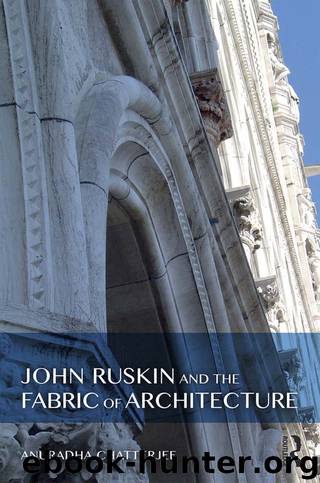John Ruskin and the Fabric of Architecture by Chatterjee Anuradha

Author:Chatterjee, Anuradha
Language: eng
Format: epub
Publisher: Taylor & Francis (CAM)
The passage provides a solution to the Carlylean paradox of the modern age, where the body almost always tended to dominate the soul. The Gothic drapery not only concealed the body but it also ensured that the body was not impressed upon the fabric surface. Furthermore, the remarkable heaviness of the drapery deterred movement, which supposedly assisted the body to be passive, and the soul to be active. The principle of “removal of agitation” as Ruskin says, or that of absence as presence was the guiding principle of the ideal dress. The flatness and verticality of the drapery created conditions whereby the body was diminished, and the soul actualized. These ideas pervaded Ruskin’s studies of drapery, especially his studies of draped and dressed female figures.
The theory of the ideal dress could be fully realized only by casting the above principles to the female body. The absolute cornerstone of this was Ilaria del Caretto, which Ruskin had started studying in 1845. His drawings of this figure were side profiles. In Modern Painters II (Ruskin 1903–1912, vol. 4, p. 122), Ruskin noted the “severe natural simplicity and perfect grace” of the dress. In “Quercia”, The Aesthetic and Mathematic Schools of Art in Florence (1874), he admired the way the dress was arranged so as to permit “soft outline of the form beneath, but from the shoulder he draws these terminal folds straight to the feet” (Ruskin 1903–1912, vol. 23, p. 231). He also explained that this was the perfect example of drapery under tension, almost as if it were vertical, and that the outline was not “absolutely straight, but curves of extreme subtlety” (ibid., p. 231). These passages emphasized the fact that even though the physical form was completely concealed by the taut and seamless surface of the dress, the body was not totally eliminated. It was refigured as a streamlined silhouette, evidenced in Ruskin’s description of St. Ursula as lying “straight, bending neither at the waist nor knee, the sheet rising and falling over her in a narrow unbroken wave, like the shape of the coverlid of the last sleep, when the turf scarcely rises” (ibid., vol. 27, pp. 343–44). This highlighted the importance of interplay between concealment and revealment.
Ruskin believed that humanity should be “content to accept only partial knowledge, even in those matters, which chiefly concern us” (ibid., vol. 6, p. 89). He compared vision to a state of dream:
Our whole happiness and power of energetic action depend upon our being able to breathe and live in the cloud; content to see it opening here and closing there; rejoicing to catch, through the thinnest films of it, glimpses of stable and substantial things; but yet perceiving a nobleness even in the concealment, and rejoicing that the kindly veil is spread where the untempered light might have scorched us, or the infinite clearness wearied.
(Ruskin 1903–1912, vol. 6, p. 89)
Download
This site does not store any files on its server. We only index and link to content provided by other sites. Please contact the content providers to delete copyright contents if any and email us, we'll remove relevant links or contents immediately.
Kathy Andrews Collection by Kathy Andrews(11325)
The remains of the day by Kazuo Ishiguro(8395)
Paper Towns by Green John(4800)
Spare by Prince Harry The Duke of Sussex(4788)
Industrial Automation from Scratch: A hands-on guide to using sensors, actuators, PLCs, HMIs, and SCADA to automate industrial processes by Olushola Akande(4604)
The Body: A Guide for Occupants by Bill Bryson(4585)
Be in a Treehouse by Pete Nelson(3648)
Machine Learning at Scale with H2O by Gregory Keys | David Whiting(3627)
Harry Potter and the Goblet Of Fire by J.K. Rowling(3609)
Never by Ken Follett(3528)
Goodbye Paradise(3446)
The Remains of the Day by Kazuo Ishiguro(3139)
Into Thin Air by Jon Krakauer(3131)
The Cellar by Natasha Preston(3077)
The Genius of Japanese Carpentry by Azby Brown(3040)
Fairy Tale by Stephen King(2949)
120 Days of Sodom by Marquis de Sade(2941)
Drawing Shortcuts: Developing Quick Drawing Skills Using Today's Technology by Leggitt Jim(2940)
The Man Who Died Twice by Richard Osman(2808)
